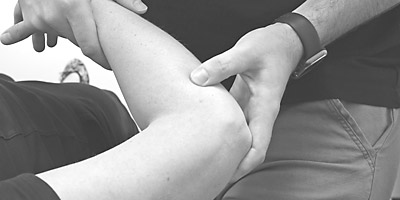Elbow pain is commonly caused by a local muscle, tendon or joint injury due to repetitive use of overloading activities, without adequate arm strength or endurance. Occasionally more severe and forceful trauma can occur in the form of fractures or complete tendon ruptures can occur. Pain at the elbow can also be referred from the shoulder or from the neck.
Your elbow lets you do a huge variety of different things because it’s not a simple joint. Because it is so important to our daily life and the things we use it for repetitively and occasionally, things can go wrong.
Your elbow’s a joint formed where three bones come together – your upper arm bone, called the humerus, and the ulna and the radius, the two bones that make up your forearm.
Each bone has cartilage on the end, which helps them slide against each other and absorb shocks. They’re held into place with tough tissues called ligaments. And your tendons connect your bones to muscles to allow you to move your arm in different ways.
If anything happens to any of these parts, not to mention the nerves, it can cause you pain.
Here are some of the different ways your elbow can hurt:
One-time Injuries: Some injuries, hopefully, are one-off events, like when you fall or get hit hard while playing a sport.
Dislocated elbow. When one of the bones that forms the elbow gets knocked out of place, you have a dislocated elbow. One of the more common causes is when you put your hand out to catch yourself during a fall. It can also happen to toddlers when you swing them by their forearms — that’s called nursemaid’s elbow.
Strains and sprains: When muscles get stretched or torn, it’s called a strain. When it’s ligaments, it’s a sprain.
You can get a strain when you put too much pressure on your elbow muscles, like when you lift heavy objects or overdo it with sports.
Elbow sprains are common in athletes who throw, use racquets, golf clubs, or play contact sports.
Both are treated with rest, ice and – once the pain is gone – stretching and strength exercises.
Wear-and-Tear Injuries
Other injuries occur over time, as you repeat certain actions and put wear and tear on your elbow. You can injure yourself playing sports or in any number of work settings, from a factory to an office.
Bursitis: Often caused by repeating the same motion over and over, you can also get bursitis from an accident or infection. Bursa are small sacs with fluid in them. You have them in your joints to help cushion your bones, tendons, and muscles. They also help skin slide over bone. But they can get swollen and cause you pain.
Tennis elbow and golfer’s elbow: These are both types of tendinitis, which means you have damage in the tendons around your elbow from overuse. Despite the names, the injuries aren’t limited to golfers or tennis players. You’re just more likely to get them based on the arm motions used in those sports. The main difference between the two is that tennis elbow affects the outside of your elbow, while golfer’s elbow affects the inside.
Trapped nerves: You might be familiar with carpal tunnel syndrome, where a nerve that passes through your wrist gets squeezed and causes some wrist and arm issues. You can have similar problems in your elbow. If you have cubital tunnel syndrome, one of the main nerves in your arm gets squeezed as it runs along the inside of your elbow and passes through tissue called the cubital tunnel. You may have burning or numbness in your hand, arm, and fingers.
Common causes of elbow pain include:
- Tendinopathies
- Muscle strains
- Bursitis
- Ligament sprains
- Arthritis, thinned cartilage, bony spurring
- Damaged muscle tissue
- Fracture from direct trauma
Common pain symptoms:
- Experience pain when performing gripping tasks
- Tenderness directly over the bony epicondyle
- Pain travelling down the forearm
- Pain with lifting and holding objects
- Locking, clicking, catching during movement
- Pain if muscle or tendon is stretched or squeezed
Elbow Treatment
- Strengthening exercises
- Massage
- Dry needling
- Mobilisation and manual therapy
- Taping or bracing
- Stretching
- Mobilising techniques
- Electrotherapy or ultrasound
Self Help
- Rest
- Compression
- Heat or ice packs
- Elevation
- Stretching
- Exercises

